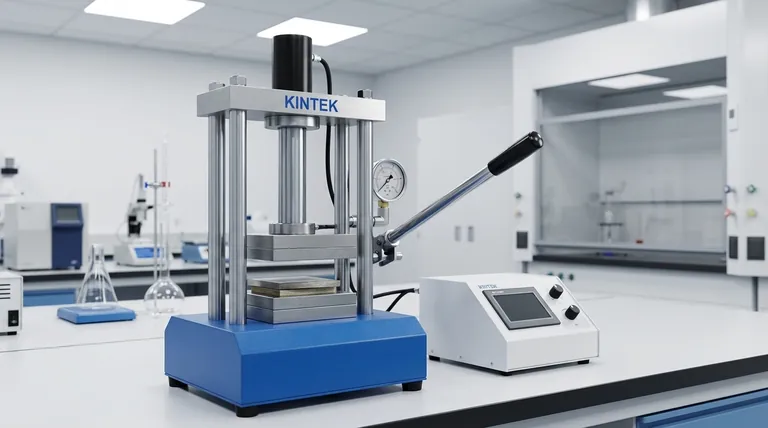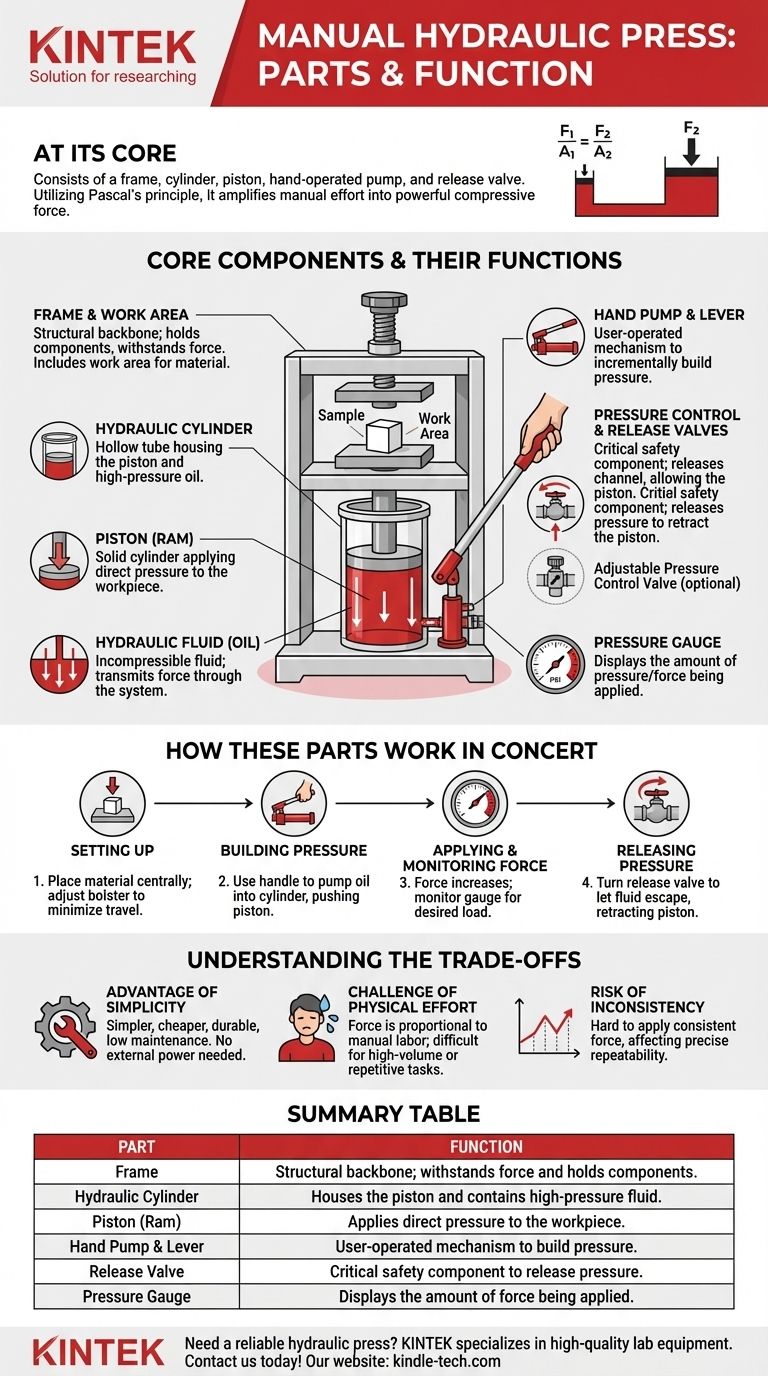At its core, a manual hydraulic press consists of a frame, a cylinder filled with hydraulic fluid, a piston that applies force, a hand-operated pump to build pressure, and a valve to release it. These components work together using the principle of fluid mechanics to multiply a small amount of manual effort into a powerful compressive force.
The fundamental purpose of these interconnected parts is to leverage Pascal's principle: force applied via a hand pump to a confined fluid is transferred and amplified, driving a piston to press, form, or shape a material with immense force.

The Core Components and Their Functions
Understanding how a manual press generates force begins with knowing the role of each individual part. While designs vary, the key functional components are universal.
The Frame and Work Area
The frame is the structural backbone of the press, holding all other components in place and withstanding the immense forces generated.
It includes the work area, where the material is placed. Many presses feature an adjustable upper bolster or a leadscrew to change the working distance and secure the workpiece before pressure is applied.
The Hydraulic Cylinder
The cylinder is a hollow tube that houses the piston and is filled with hydraulic oil. It is engineered to contain the high pressure that is built up during operation.
The Piston (or Ram)
The piston is a solid cylinder that moves within the hydraulic cylinder. As hydraulic fluid is pumped into the cylinder, the piston is forced out, applying direct pressure to the workpiece.
The Hydraulic Fluid (Oil)
Hydraulic oil is the incompressible fluid that transmits force through the system. It is the medium that transfers the energy from the pump to the piston.
The Hand Pump and Lever
This is the user's interface for generating force. By operating the hand pump with a lever, the user forces hydraulic oil into the main cylinder, building pressure incrementally.
The Pressure Control & Release Valves
The pressure release valve is a critical safety and operational component. Turning this valve allows the hydraulic fluid to return to its reservoir, releasing the pressure and retracting the piston.
Some models also include an adjustable pressure control valve to set a maximum force limit, preventing over-pressuring.
The Pressure Gauge
A pressure gauge displays the amount of pressure currently being applied by the piston. This component is essential for applications requiring a specific, measurable force, such as in laboratory sample preparation.
How These Parts Work in Concert
The operation of a manual hydraulic press is a straightforward sequence of events where each component plays a critical role in a chain reaction.
1. Setting Up the Workpiece
First, the material is placed centrally on the base plate or the lowered piston. The upper bolster or leadscrew is adjusted to be close to or touching the workpiece, minimizing the travel distance required for the piston.
2. Building Pressure
The operator then uses the handle to pump the hydraulic system. Each pump stroke forces a small amount of oil into the main cylinder, pushing the piston up (or down, depending on the design) and slowly applying a load to the workpiece.
3. Applying and Monitoring Force
As pumping continues, the force increases. The operator monitors the pressure gauge until the desired load—measured in tons or pounds per square inch (PSI)—is achieved.
4. Releasing the Pressure
Once the task is complete, the operator turns the release valve. This opens a channel for the high-pressure fluid to escape the cylinder, allowing the piston to retract and releasing the force from the workpiece.
Understanding the Trade-offs
The simple design of a manual press offers clear benefits but also comes with inherent limitations you must consider.
The Advantage of Simplicity
Lacking complex electronic components, manual presses are generally less expensive, more durable, and easier to maintain. They do not require an external power source, making them versatile for various workshop environments.
The Challenge of Physical Effort
The force generated is directly proportional to the physical effort exerted by the operator. Achieving and sustaining high tonnage requires significant manual labor, which may not be suitable for high-volume or repetitive tasks.
The Risk of Inconsistency
Because pressure application is controlled by hand, it can be difficult to apply force with perfect consistency from one operation to the next. This can be a drawback in processes where precise repeatability is critical.
Making the Right Choice for Your Application
Knowing the function of each part helps you select a press that aligns with your specific needs.
- If your primary focus is laboratory sample preparation (e.g., KBr, XRF): You need a press with a clear, accurate pressure gauge and safety features like polycarbonate guards.
- If your primary focus is general workshop tasks (e.g., bearing removal, metal forming): Durability, a strong frame, and a high-tonnage capacity are your most important considerations.
- If your primary focus is high-volume production: The physical effort and potential inconsistency of a manual press may be a bottleneck, and a powered press could be a better long-term solution.
By understanding how these simple parts create extraordinary force, you can operate a manual press safely and effectively.
Summary Table:
| Part | Function |
|---|---|
| Frame | Structural backbone that withstands force and holds components. |
| Hydraulic Cylinder | Houses the piston and contains high-pressure fluid. |
| Piston (Ram) | Applies direct pressure to the workpiece. |
| Hand Pump & Lever | User-operated mechanism to build pressure. |
| Release Valve | Critical safety component to release pressure and retract the piston. |
| Pressure Gauge | Displays the amount of force being applied. |
Need a reliable hydraulic press for your lab or workshop? KINTEK specializes in high-quality lab equipment, including manual hydraulic presses designed for precision and durability. Whether you're preparing laboratory samples or performing workshop tasks, our presses deliver consistent, powerful force. Contact us today to find the perfect press for your application and experience the KINTEK difference in performance and support.
Visual Guide

Related Products
- Manual Lab Heat Press
- Laboratory Manual Hydraulic Pellet Press for Lab Use
- Automatic Laboratory Hydraulic Press for XRF & KBR Pellet Press
- Laboratory Manual Hydraulic Pellet Press for Lab Use
- Laboratory Hydraulic Press Split Electric Lab Pellet Press
People Also Ask
- What is a hydraulic press in simple words? Harness Immense Force for Shaping and Crushing
- What does a manual press do? Understand the Two Key Types for Your Lab or Industrial Needs
- How much force can a hydraulic press exert? Understanding its immense power and design limits.
- What is an automatic press machine? High-Precision Force for Modern Manufacturing
- What is the construction of a hydraulic press based on? Unlocking the Power of Pascal's Law



















